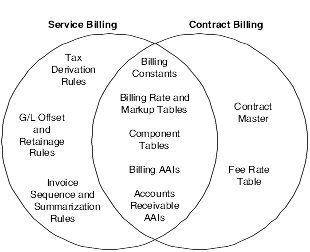Understanding Setup Requirements
Before you can use JD Edwards EnterpriseOne Contract Billing and JD Edwards EnterpriseOne Service Billing, you must define the constants and rules that you want to use during billing processes. The information that you define in the billing constants and rules specifies:
How the system determines what number to assign to billing control, component link, reburdening adjustment group (RAG), and contract records.
How the system uses dates (such as service and tax dates, general ledger dates, and various effective dates) in combination with billing AAIs (automatic accounting instructions), markup rules, and tax derivation rules to process source transactions.
How the system uses billing AAIs to create journal entries.
How the system processes billable transactions from the JD Edwards EnterpriseOne Payroll and Time Accounting systems.
This table describes the setup features for JD Edwards EnterpriseOne Contract Billing and JD Edwards EnterpriseOne Service Billing:
Setup Feature |
Description |
|---|---|
Billing Constants |
Control the global processing of:
|
Next numbers |
Identify the next number for the system to use for these records in system code 48:
Identify the next number for the system to use for these records in system code 52: Contract Number. You set up next numbers in the Next Numbers program (P0002). |
Billing Rate and Markup Rules |
Define the calculation for the amount that you add to costs to account for overhead and profit. |
Billing AAIs |
Define the accounting rules that the system uses to process journal transactions for billing, revenue recognition, and reallocations. |
Component Rules |
Define an additional markup that is based on amounts and units. The markup rules use this information to define additional markup. |
General Ledger Offset and Retainage Rules |
Identify the:
|
Tax Derivation Rules |
Define the:
|
AAIs |
Define accounting information and general ledger relationships. |
User-Defined Codes |
Define custom codes for the system, such as component codes and adjustment reasons. |
Sequence and Summarization Rules |
Define how you want the system to sequence and summarize the transaction information that appears on invoices. Note: Contract Billing does not use Sequence and Summarization Rules. |
This diagram illustrates the differences in the setup of JD Edwards EnterpriseOne Contract Billing and Service Billing:
